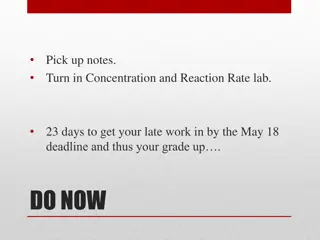Equilibrium and Acid-Base Problems in Chemistry Lecture
In this lecture, topics such as Advanced Equilibrium, Acid/Base Equilibria, Systematic Method for solving chemical problems, Strong Acid/Strong Base scenarios, and General Comments on reactions are discussed. Examples using the systematic method are provided for practical understanding. Key points on utilizing the systematic approach, coupled reactions, and effects of secondary reactions are detailed, along with a focus on Weak Acid Problems and pH calculations. Various methods such as ICE method and software solutions are covered for solving chemical equilibrium problems.
Uploaded on Oct 09, 2024 | 0 Views
Download Presentation

Please find below an Image/Link to download the presentation.
The content on the website is provided AS IS for your information and personal use only. It may not be sold, licensed, or shared on other websites without obtaining consent from the author.If you encounter any issues during the download, it is possible that the publisher has removed the file from their server.
You are allowed to download the files provided on this website for personal or commercial use, subject to the condition that they are used lawfully. All files are the property of their respective owners.
The content on the website is provided AS IS for your information and personal use only. It may not be sold, licensed, or shared on other websites without obtaining consent from the author.
E N D
Presentation Transcript
Announcements Labs Due Wednesday GC Today s Lecture Chapter 8 Advanced Equilibrium The systematic method and its six steps more practice Generalities about using the systematic method Chapter 9 Acid/Base Equilibria The weak acid problem (pH of weak acid in water) The weak base problem
The Systematic Method 2ndExample An aqueous mixture of CdCl2and NaSCN is made Initial concentrations are [CdCl2] = 0.0080 M and [NaSCN] = 0.0040 M Cd2+reacts with SCN-to form CdSCN+K = 95 HSCN is a strong acid Ignore any other reactions (e.g. formation of CdOH+) Ignore activity considerations Go through steps 1 through 5
The Systematic Method 3rdExample A student prepares a solution that contains 0.050 mol of AgNO3and 0.0040 mol NH3in water with a total volume of 1.00 L. The AgNO3is totally soluble, NH3 is a weak base, and Ag+reacts with NH3 to form Ag(NH3)2+. Assume the Ag+ does not react with water or OH-. Go through the first 5 steps of the systematic method.
The Systematic Method Stong Acid/Strong Base Problems When do we need to use the systematic approach? when more than 1 coupled reaction occur (unless coupling is insignificant) examples: 4.0 x 10-3M HCl. 7.2 x 10-3M NaOH Key point is the charge balance equation: - for strong acid HX, [H+] = [X-] + [OH-] - If [X-] >> [OH-], then [H+] = [X-] for strong base NaOH, [H+] + [Na+] = [OH-]
The Systematic Method General Comments Effects of secondary reactions e.g. MgCO3dissolution Additional reactions increase solubility Secondary reactions also can affect pH (CO32- + H2O will produce OH-while Mg2++ H2O will produce H+) Software is also available to solve these types of problems (but still need to know steps 1 5 to get problems solved)
Acid Base Equilibria (Ch. 9) Weak Acid Problems: e.g. What is the pH and the concentration of major species in a 2.0 x 10-4M HCO2H (formic acid, Ka= 1.80 x 10-4) solution ? Can use either systematic method or ICE method. Systematic method will give correct answers, but full solution results in cubic equation ICE method works most of the time Use of systematic method with assumptions allows determining when ICE method can be used
Acid Base Equilibria Weak Acid Problem cont.: Systematic Approach (HCO2H = HA to make problem more general where HA = weak acid) Step 1 (Equations) HA H2O Step 2: Charge Balance Equation: [H+] = [A-] + [OH-] 2 assumptions possible: ([A-] >> [OH-] assumption used in ICE method or [A-] << [OH-]) Step 3: Mass Balance Equation: [HA]o= 2.0 x 10-4M = [HA] + [A-] Step 4: Kw= [H+][OH-] and Ka= [A-][H+]/[HA] Step 5: 4 equations (1 ea. steps 2 + 3, 2 equa. step 4), unk.: [HA], [A-] [H+], [OH-] H++ A- H++ OH-
Acid Base Equilibria Weak Acid Problem cont.: Assumption #1: [A-] >> [OH-] so [A-] = [H+] Discussion: this assumption means that we expect that there will be more H+from formic acid than from water. This assumption makes sense when [HA]ois large and Kais not that small (valid for [HA]o>10-6M for formic acid) ICE approach (Gives same result as systematic method if assumption #1 is made) (Equations) HA H++ A- Initital 2.0 x 10-4 0 0 Change - x +x +x Equil. 2.0 x 10-4 x x x
Acid Base Equilibria Weak Acid Problem Using ICE Approach Ka= [H+][A-]/[HA] = x2/(2.0 x 10-4 x) x = 1.2 x 10-4 M (using quadratic equation) Note: sometimes (but not in this case), a 2nd assumption can be made that x << 2.0 x 10-4to avoid needing to use the quadratic equation [H+] = [A-] = 1.2 x 10-4 M; pH = 3.92 [HA] = 2.0 x 10-4 1.2 x 10-4= 8 x 10-5M Note: = fraction of dissociation = [A-]/[HA]total = 1.2 x 10-4 /2.0 x 10-4= 0.60
Acid Base Equilibria Weak Acid Problem cont.: When is Assumption #1 valid (in general)? When both [HA]oand Ka are high or so long as [H+] > 10-6M More precisely, when [HA]o> 10-6M and Ka[HA]o> 10-12 See chart (shows region where error < 1%) Failure also can give [H+] < 1.0 x 10-7M Where ICE Method Works 1.00E+00 1.00E-01 Assupmption #1 Works 1.00E-02 1.00E-03 [HA]o 1.00E-04 1.00E-05 Fails 1.00E-06 1.00E-07 1E-10 1E-08 1E-06 0.0001 0.01 1 Ka
Acid Base Equilibria Weak Base Problem: As with weak acid problem, ICE approach can generally be used (except when [OH-] from base is not much more than [OH-] from water) Note: when using ICE method, must have correct reaction Example: Determine pH of 0.010 M NH3 solution (Ka(NH4+) = 5.7 x 10-10, so Kb = Kw/Ka = 1.75 x 10-5) Reaction NH3 + H2O NH4+ + OH- Go over on board
Acid Base Equilibria Weak Acid/Weak Base Questions: A solution is prepared by dissolving 0.10 moles of NH4NO3 into water to make 1.00 L of solution. Show how to set up this problem for determining the pH using the ICE method. A student is solving a weak base problem for a weak base initially at 1.00 x 10-4 M using the ICE method and calculates that [OH-] = 2.4 x 10-8 M. Was the ICE method appropriate? The pH of an unknown weak acid prepared to a concentration 0.0100 M is measured and found to be 3.77. Calculate and Ka.
























